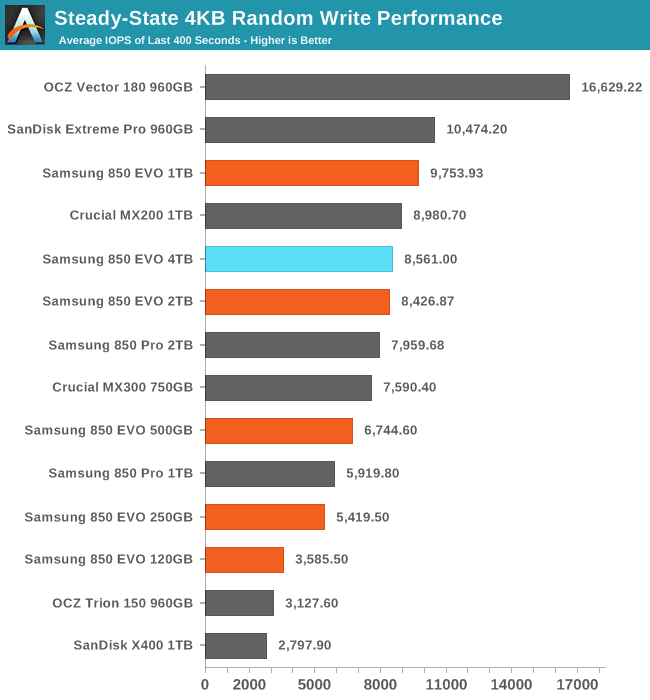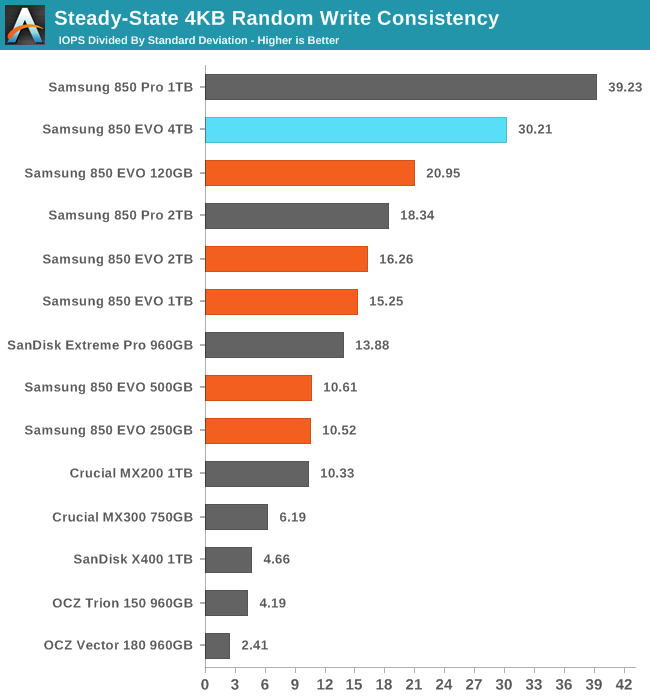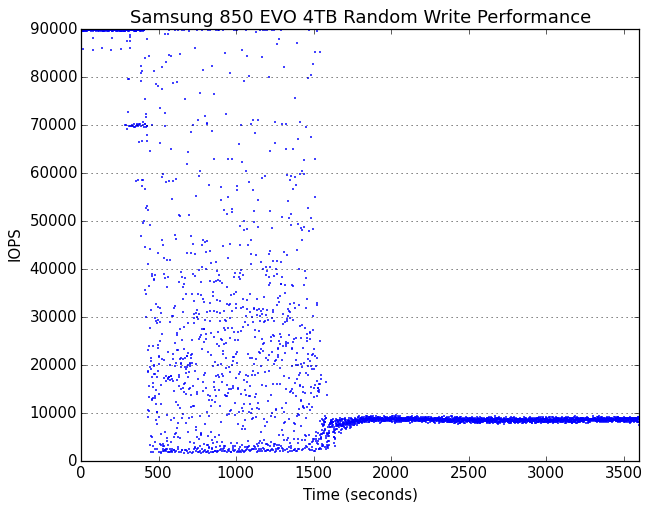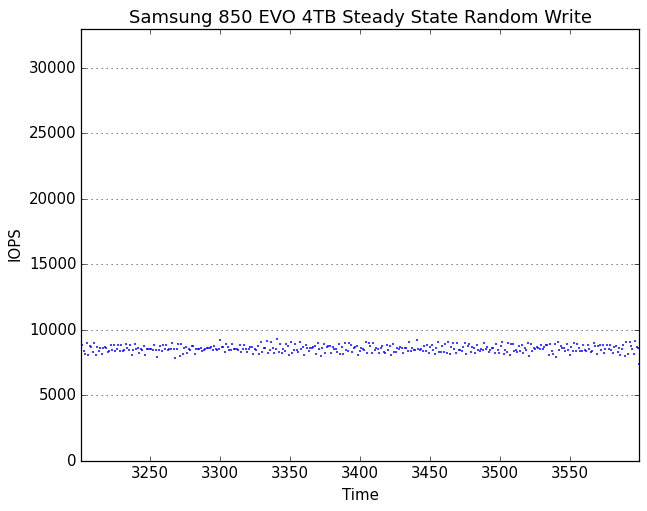The Samsung 850 EVO 4TB SSD Review
by Billy Tallis on July 11, 2016 10:00 AM ESTPerformance Consistency
Our performance consistency test explores the extent to which a drive can reliably sustain performance during a long-duration random write test. Specifications for consumer drives typically list peak performance numbers only attainable in ideal conditions. The performance in a worst-case scenario can be drastically different as over the course of a long test drives can run out of spare area, have to start performing garbage collection, and sometimes even reach power or thermal limits.
In addition to an overall decline in performance, a long test can show patterns in how performance varies on shorter timescales. Some drives will exhibit very little variance in performance from second to second, while others will show massive drops in performance during each garbage collection cycle but otherwise maintain good performance, and others show constantly wide variance. If a drive periodically slows to hard drive levels of performance, it may feel slow to use even if its overall average performance is very high.
To maximally stress the drive's controller and force it to perform garbage collection and wear leveling, this test conducts 4kB random writes with a queue depth of 32. The drive is filled before the start of the test, and the test duration is one hour. Any spare area will be exhausted early in the test and by the end of the hour even the largest drives with the most overprovisioning will have reached a steady state. We use the last 400 seconds of the test to score the drive both on steady-state average writes per second and on its performance divided by the standard deviation.

The 4TB 850 EVO restores a little bit of the performance that the 2TB lost relative to the 1TB, but Samsung's controller architecture is still clearly most comfortable at 1TB.

The consistency of the 2TB 850 EVO was only slightly better than the 1TB EVO, so it's surprising to see the 4TB model make such a large jump and come so close to the 1TB 850 Pro.
 |
|||||||||
| Default | |||||||||
| 25% Over-Provisioning | |||||||||
It is no surprise that a 4TB drive lasts so long before dropping out of peak performance: it has far more spare area to burn through than any ordinary consumer SATA SSD. The transition to steady state is uncharacteristically long and messy for a Samsung drive, and the performance lows during this period are disappointing. Once the drive has reached steady state, there's nothing to complain about.
 |
|||||||||
| Default | |||||||||
| 25% Over-Provisioning | |||||||||
There are no wild outliers from the 4TB 850 EVO's steady-state, and none of the longer-term drift in performance shown by the 1TB and 2TB 850 EVO and Pro models. With extra overprovisioning, the 4TB EVO carries on indefinitely with high and extremely steady performance.










145 Comments
View All Comments
SetiroN - Monday, July 11, 2016 - link
I mean I understand and agree that Samsungs are the better drives to buy at lower capacities right now, but if you needed 4TB or more you just have to be silly to spend $700 more.Let me say that again: $700.
Oxford Guy - Monday, July 11, 2016 - link
"I can't honestly think of any good reason to buy something other than samsung SSD"1) People who were burned by the very poor steady state performance (according to one professional review site) of the original 840 120 GB.
2) People who were burned by the problems with the 840 EVO and who aren't impressed by the kludgy work-around of re-writing data again and again.
3) People who haven't been impressed with generations of BS power consumption specs. It's only recently that we're now seeing ratings for read/write power consumption. Prior to that, though, there generations/years of Samsung SSDs with ".17 watt" power consumption nonsense. This was not only the only thing on their site for SSDs that used plenty of watts when working (like the 830 and 840) — consumers even advised each other in the comments in places like this to choose Samsung because of the very low power consumption (even though the 840 topped the chart here, as I recall, for consuming the most watts when writing).
But, that said, the 850 seems to be the first decent TLC SSD so I'm glad the company has made significant improvement.
Impulses - Monday, July 11, 2016 - link
I guess I got lucky, went straight from 830s to 850 EVOs & SM951, have yet to get burnt. Though to be honest, every other SSD OEM out there (including Intel) had at least one catastrophic scenario like the 840's (often worse, resulting in data loss), if not several such scenarios.I'm not completely excusing Samsung, because their handling of the situation wasn't optimal (went from trying to brush it under that rug to a kludgy fix that didn't even cover the non EVO)... But I'm also not holding it against them.
Palorim12 - Tuesday, July 12, 2016 - link
1. They released a fix it a week or two ago.2. completely fixed in April of 2015. Doesn't constantly rewrite data, the new algorithm itself fixes the read speeds and the idle write thing they have is a just in case the algorithm can't fix it.
3. Use desktops, so can't say anything about power consumption.
romrunning - Monday, July 11, 2016 - link
Sure, the *1TB* Ultra II is cheaper per GB. But show me where I can buy a 4TB Ultra II, and then you'll have an apples-to-apples comparison.ddriver - Monday, July 11, 2016 - link
Well, you can't, but you can buy 4 1TB, put them in RAID 0 and get 2 GB/sec vs 500 MB/sec from the EVO.So almost the same capacity (it is 960 GB really) at 4 times the speed (and 4 times less reliability ;) for 2/3 of the cost.
quiksilvr - Monday, July 11, 2016 - link
That is only a viable option if you have a desktop computer or a Thunderbolt external drive enclosure. An initial price of $1499 is a lot but 4TB is ridiculous. And if that price drops to $999, that would be even more bonkers. I remember the days when having just 1TB was that price. The fact that we are at 4 times the capacity for the same price and WAY better performance is nuts.TemjinGold - Monday, July 11, 2016 - link
And 4 times the headaches having to deal with the RAID setup.mapesdhs - Wednesday, July 13, 2016 - link
And the reliability issue of one device failure trashing all the data, though one could get round this by using four 2TB in RAID10 which wouldn't be so bad, but still a lot of ports, etc.Gigaplex - Monday, July 11, 2016 - link
I'd also need a RAID controller with 4 spare SATA ports.